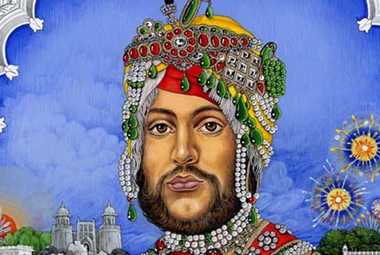The Exiled Child-Prince Maharajah Duleep Singh and Scotland
In September 2012, a memorial, organised by the Anglo Sikh Heritage Trust (ASHT), took place in Kenmore Parish Church graveyard in Perthshire for a young baby who died in 1865. This baby, who had no name, was the son of the Maharajah Duleep Singh and his wife Bamba Muller.
The Maharajah Duleep Singh was the exiled prince of the Punjab (a Sikh Empire in north western India) who was born in 1838. In 1849, aged only 10, Duleep Singh was removed from the Punjab (and his mother) by the British who removed his title and devolved his power. The Koh-i-noor diamond was “surrendered” to the East India Company and later presented to Queen Victoria. Duleep Singh became the ward of Sir John Spencer Login, a Scottish surgeon, and his wife Lena Campbell Login and they brought him to England in 1854 after he had converted to Christianity.
In England, still a teenager, Duleep Singh became a ‘favourite’ of Queen Victoria. As a former prince (and thus of ‘royal blood’), he was able to be presented in the Queen’s Court and became close to her family. In 1855, Login rented Castle Menzies in Perthshire, a large sporting estate, and Duleep Singh moved there with an annual pension. Known to dress in kilts and Highland costume, he became ‘something of a local legend’ and was known by some as the Black Prince of Perthshire. Duleep Singh particularly enjoyed hunting and grouse shooting as well as falconry. In Login’s accounts it became clear that Login did not like Duleep Singh’s practice of flying his falcons at grouse because he thought it was unnecessarily cruel. Stories of Duleep Singh’s ‘Eastern nature’ of cruelty have emerged from this time – stories told by Login and his friends - which point to the ways in which British (including Scottish) people liked to revert to stereotypes about Indians, even with someone they knew so well.
In 1864, Duleep Singh married Bamba Müller (of German and Ethiopian descent) in Cairo and then established his family at Elveden Hall in Suffolk. They had six children together (who survived infancy) and Queen Victoria was godmother to their children. One of their daughters, Sophia Duleep Singh, later became a prominent British suffragette.
In Elveden, Duleep Singh continued to be known for his so-called extravagant lifestyle, his love for the countryside and game-shooting. He also rebuilt the church, cottages and school in Elveden. Despite his upbringing and the attempts by Login and the British state to monitor his ‘Indianness’, in 1886 Duleep Singh decided to fight to reclaim his land and title in Punjab, returning to India and re-converting to Sikhism. He was unsuccessful and then moved to Paris where he had two more children with Ada Wetherill and died in 1893. His body was buried in Elveden.
On 4 August 1865, Duleep Singh and Muller’s first son was born, but tragically the baby only lived for 24 hours. The baby was not named, but was born a Christian and buried in Kenmore Parish Church. The inscription on the grave reads: “To the memory of the infant son of the Maharajah Duleep Singh, late ruler of the Sikh Nation, Punjab, India and the Maharanee, his wife. Born 4th August 1865. Died 5th August 1865.”
The tragic death of this baby and its burial in Scotland points to the ways in which an Indian presence in Scotland dates back to at least the mid-nineteenth century. Indians were not just ‘present’ they were engaging with Scottish people, buried on Scottish land, shaping Scottish culture. But Scots were also involved in British colonialism and the subjection of Indian people. Login was not unusual as a Scot for being heavily involved with the East India Company’s army, political apparatus and in shoring up the colonial state.
There are also interesting points to make about empire’s children and how they were treated. The baby buried in Kenmore epitomises the kind of Indian that the imperial state wanted to control – young, silent, docile, passive. The Maharajah Duleep Singh was divested of his power as a very young child. He was seen as someone who could be moulded and ‘saved’ by British imperial power and Christianity. The imperial state robbed an ‘innocent’ of his heritage, even if he was then able to have large estates in Perthshire or Suffolk. There are parallels in the ways in which this individual child was treated and the ways in which imperial thought depicted India as a childlike country, which was primitive and innocent and needed to be ‘guided’ by the ‘adult’ British power. Meanwhile, Indian civilisation and the Sikh Empire were seen as senile or dead and no longer relevant to the modern age. In removing Duleep Singh from his home and his mother, it was easy to wrest power from the Punjab ruler. As he was a child it was easy to make him a favourite at Queen Victoria’s court. However, as we see in his later life, and in the activities of his daughter Sophia, the Duleep Singhs’ imperial guardians could not prevent the political awakening and realisation of injustice that came with adulthood.
